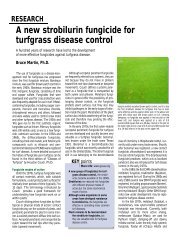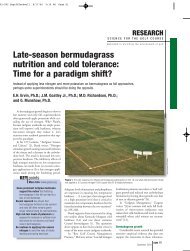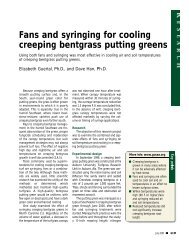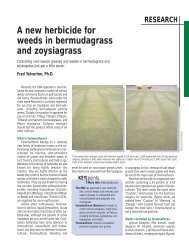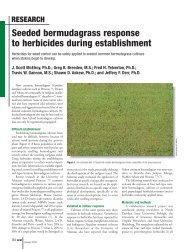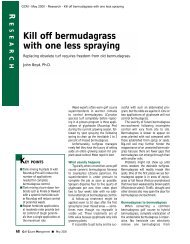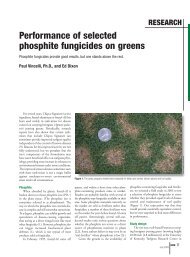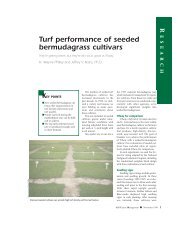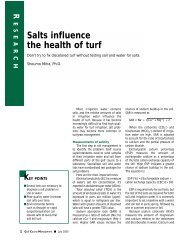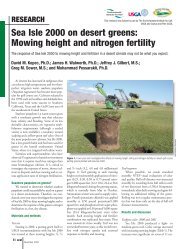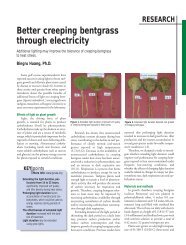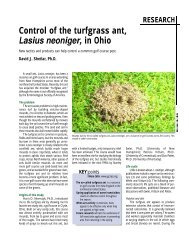Managing salts in soil and irrigation water - GCSAA
Managing salts in soil and irrigation water - GCSAA
Managing salts in soil and irrigation water - GCSAA
Create successful ePaper yourself
Turn your PDF publications into a flip-book with our unique Google optimized e-Paper software.
GCM - January 2001 - Research - <strong>Manag<strong>in</strong>g</strong> <strong>salts</strong> <strong>in</strong> <strong>soil</strong> <strong>and</strong> <strong>irrigation</strong> <strong>water</strong>when gypsum is added to the <strong>soil</strong>, thegypsum may revert to <strong>in</strong>soluble lime(CaCO 3 ) <strong>in</strong> the presence of excessHCO 3- <strong>and</strong> CO3 = (3). Hence, <strong>in</strong> orderto use sulfur to form gypsum, it is necessarytoremove excessive HCO 3- <strong>and</strong>CO 3=. Super<strong>in</strong>tendents should be verycareful when they use sulfur burners,because, under anaerobic conditions,reduced forms of sulfur may lead toblack-layer problems later on. Therefore,sulfur products should be used <strong>in</strong>areas that are well aerated <strong>and</strong> have no<strong>in</strong>filtration problems.Another reason super<strong>in</strong>tendents useacid-<strong>in</strong>jection systems is to reduce <strong>soil</strong>pH. Unfortunately <strong>soil</strong> pH cannot bechanged easily by such acid applications,because <strong>soil</strong> has a huge buffer<strong>in</strong>gcapacity. Reduc<strong>in</strong>g <strong>soil</strong> pH is very difficultor even impossible <strong>in</strong> highlybuffered, calcareous <strong>soil</strong>s (3). It is muchmore practical <strong>and</strong> also less expensive toreduce <strong>soil</strong> pH by spread<strong>in</strong>g sulfur overdry <strong>soil</strong> as an amendment.A few super<strong>in</strong>tendents use acid <strong>in</strong>jection<strong>in</strong> order to prevent the precipitationof calcium <strong>and</strong> magnesium carbonates<strong>in</strong> <strong>irrigation</strong> plumb<strong>in</strong>g, but thisproblem can be solved with muchcheaper materials. A weak organic acid<strong>and</strong> a weak organic base comb<strong>in</strong>ationwill take care of the problem, <strong>and</strong> thesetypes of materials are readily available<strong>and</strong> relatively <strong>in</strong>expensive.on threshold EC values, but f<strong>in</strong>al selectionshould be made after check<strong>in</strong>g thegrowth vs. EC level, threshold EC valuesfor 50 percent growth reduction ofshoot <strong>and</strong> root. Seashore paspalum hashigh sal<strong>in</strong>ity tolerance, can tolerate<strong>water</strong>logg<strong>in</strong>g <strong>and</strong> has a low <strong>soil</strong>-oxygenrequirement (4). These attributes makeseashore paspalum an ideal turfgrasscultivar for warm-climate golf coursesfac<strong>in</strong>g severe sal<strong>in</strong>ity problems.Leach<strong>in</strong>gLeach<strong>in</strong>g of excess <strong>salts</strong> is the mostimportant step <strong>in</strong> manag<strong>in</strong>g <strong>salts</strong>.Without leach<strong>in</strong>g, the replaced sodium<strong>and</strong> the excess <strong>salts</strong> beyond the rootzone plague turf. It is difficult to leachpush-up greens or other parts of thegolf course that have f<strong>in</strong>er <strong>soil</strong> texture.Leach<strong>in</strong>g is more of an art, which asuper<strong>in</strong>tendent learns through experience<strong>and</strong> knowledge about the <strong>soil</strong> texture,the amount of <strong>water</strong> required orthe time needed for a particular green.If we try to underst<strong>and</strong> the movementof <strong>water</strong> through a <strong>soil</strong> profile, wewill f<strong>in</strong>d that, accord<strong>in</strong>g to the laws ofhydraulic conductivity, a particular <strong>soil</strong>horizon will release <strong>water</strong> as soon as itreaches field capacity. Water movesAtomic weightsR E S E A R C HSelection of turfgrassProper turfgrass selection is animportant management tool when sal<strong>in</strong>ityproblems are anticipated. Differentcultivars have differential responses tosal<strong>in</strong>ity levels. For example, commoncentipedegrass (Eremochloa ophiuroides)is sensitive to salt levels, whereasseashore paspalum (Paspalum vag<strong>in</strong>atum)can tolerate higher sal<strong>in</strong>ity levels(14 decisiemens per meter) (1). Salt-sensitiveplants (glycophytes) should bereplaced with halophytes. When select<strong>in</strong>ga turfgrass species, it is advisable tocheck the growth versus EC curves forthat particular species. Turfgrass selectionfor sal<strong>in</strong>ity tolerance is often basedFor some calculations of <strong>water</strong> quality, units must be expressed as millequivalentsper liter. Generally, labs report values <strong>in</strong> parts per million or milligramsper liter. Such values need to be divided by the equivalent weight toobta<strong>in</strong> millequivalents per liter.Ions Atomic/molecular Equivalentweight (grams) Valence weight (meq/liter)Ca ++ 40 2 20Mg ++ 24 2 12Na + 23 1 23HCO 3- 61 1 61CO 3=60 2 30Golf Course Management ■ January 2001 73



